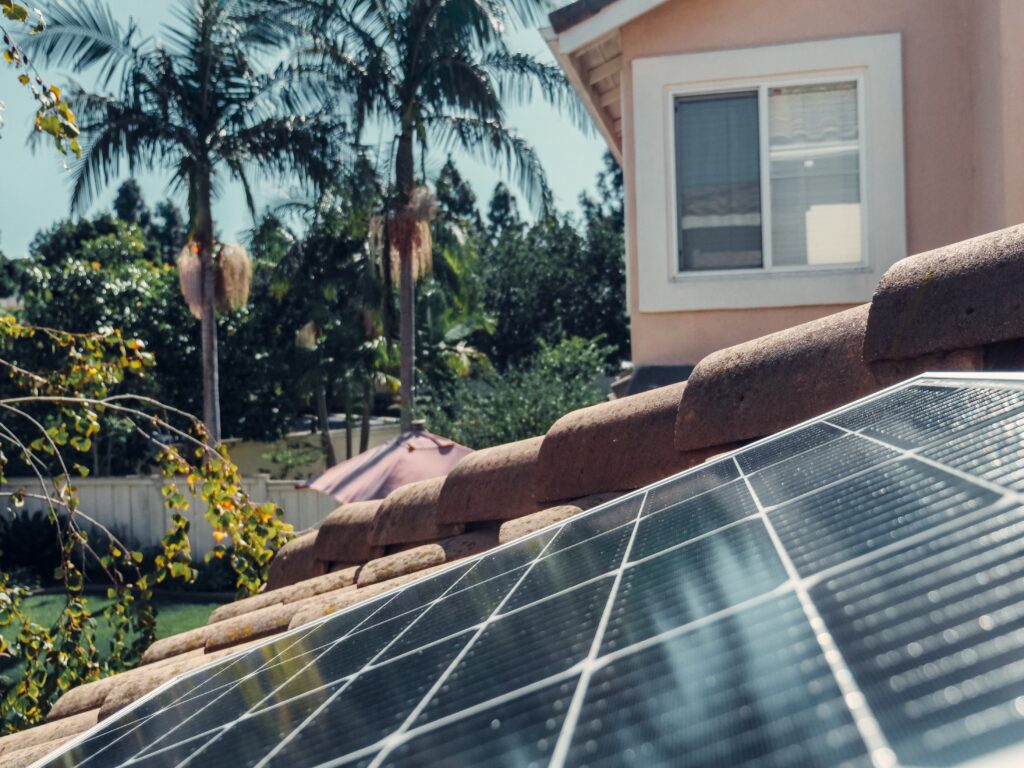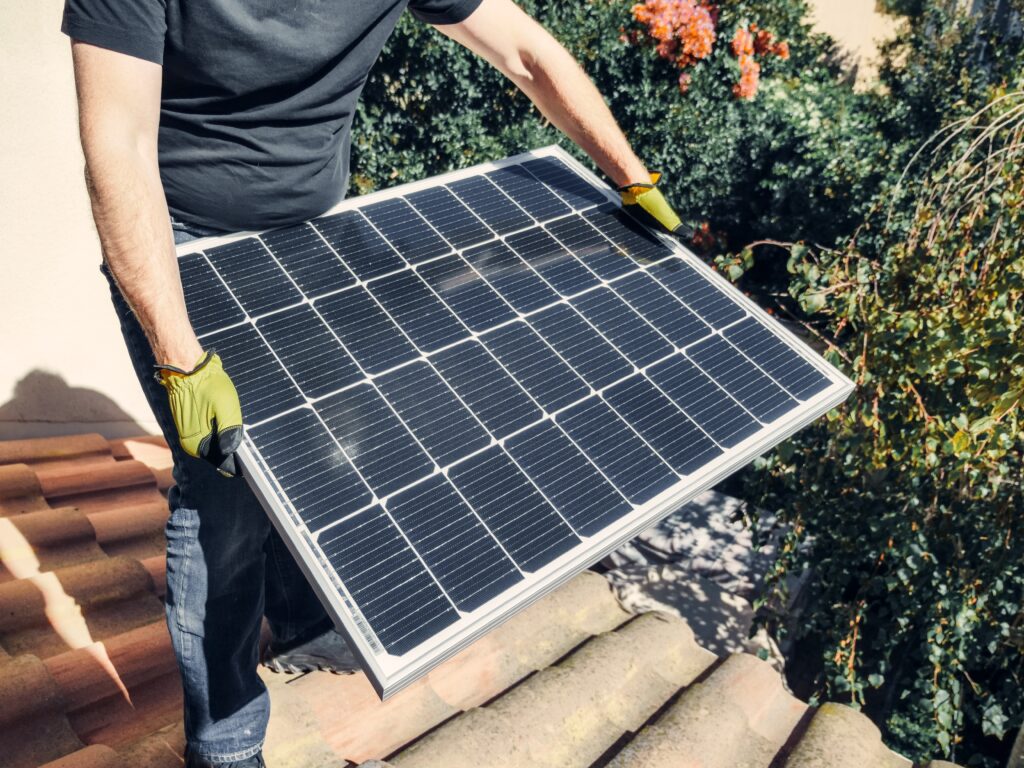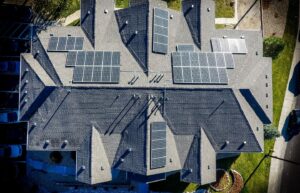Have you ever wondered how photovoltaic panels work and why they have gained so much popularity in recent years? Solar energy, generated by the sun through PV panels, is a renewable source of electricity. Imagine harnessing the power of solar technology to generate clean and sustainable electricity using solar cells and photovoltaic panels.
With the advancements in solar battery technology, it is now possible to store and utilize the energy from the sun efficiently. Solar technology is a fascinating concept that has captivated scientists, environmentalists, and everyday individuals alike. Green roofs are also an intriguing aspect of this technology. It is amazing to see how these technologies are making a positive impact on the world.
Join us on this journey as we unravel the mysteries behind solar energy, harnessing the power of the sun to generate clean and renewable light. Together, we’ll explore how solar energy can shape our future by powering green roofs and conserving water. Let’s explore the science, technology, and potential of solar electricity, solar cells, solar cookers, and water, this incredible renewable resource.
How Solar Energy Works: A Step-by-Step Guide

Photons from Sunlight Hit Solar Panels, Creating an Electric Current
When the sun’s heat reaches the roofs, it interacts with the photovoltaic cells present in the solar panels. This interaction generates water and powers various applications. These solar cells are made up of semiconductor materials, such as silicon, which have unique properties that allow them to convert sunlight into electricity to power solar technology.
Solar technology includes solar cookers, which use the heat from the sun to cook food or heat water. As photons from sunlight strike the surface of the solar panels, they excite electrons within the semiconductor material, converting light into heat and generating electricity. The heat generated can be used to warm water or heat buildings, while the roofs provide a suitable surface for capturing sunlight.
Once these electrons are excited by the sun’s heat, they move around more vigorously, powering the solar cells. This movement creates an electric current within the solar panel system, harnessing the power of the sun’s heat and water on roofs. The generated electricity from solar cells is in direct current (DC) form at this stage. It is produced by converting the heat from the sun into electrical energy using water.
The Current Flows Through an Inverter, Which Converts it Into Usable Electricity
Direct current (DC) electricity produced by solar panels needs to be converted into alternating current (AC) before it can be used to power our homes, businesses, and rooftops. The sun’s energy is harnessed by solar panels to generate DC electricity, which is then transformed into AC electricity for practical use.
This conversion process ensures that the water on our roofs receives the necessary power supply. This conversion is achieved through a device called an inverter, which helps convert the sun’s energy captured by solar cells into usable electricity.
Solar cells, typically installed on roofs, harness the power of the sun to generate electricity by converting sunlight into direct current (DC) electricity. This DC electricity is converted into alternating current (AC) electricity by the inverter, making it suitable for use in homes or businesses. This process is environmentally friendly and sustainable, as it relies on abundant and renewable energy from the sun rather than fossil fuels or water.
The inverter converts the DC electricity produced by the solar panels into AC electricity that matches the standard electrical grid’s frequency and voltage requirements, ensuring efficient use of water resources. Once converted, solar cells can produce usable AC electricity that can power various appliances and devices in our daily lives. This renewable energy source is generated by harnessing the power of the sun and does not rely on water.
Excess Electricity can be Stored in Batteries or Fed Back Into the Grid
Solar energy systems often produce more electricity than is immediately needed for consumption, but this excess power can be stored or used to generate clean water. In such cases, when there is excess energy generated by solar cells, there are two main options for managing this energy: storing it in batteries or feeding it back into the grid. This is especially useful for areas where water is scarce.
Battery Storage
Excess electricity generated by solar cells can be stored in batteries for later use when sunlight is unavailable or during high demand. This helps ensure a continuous and reliable power supply, even when water is scarce. This allows homeowners and businesses to have a reliable source of energy even when there isn’t sufficient sunlight.
Grid Connection
Alternatively, surplus energy can be fed back into the electrical grid through a process known as net metering or feed-in tariffs. In this way, the excess electricity generated by solar panels is sent back to the grid, and the system owner receives credits or compensation for the energy they contribute.
Solar energy systems maximize their efficiency and ensure a continuous supply of renewable power by either storing excess electricity or feeding it back into the grid.
Pros and Cons of Solar Energy: Examining the Benefits and Limitations
Solar energy is a rapidly growing renewable energy source that has gained significant attention in recent years. As more people become aware of the environmental impact of traditional energy sources, such as fossil fuels, they are turning to solar power as a cleaner alternative.
Pros: Reduced Electricity Bills and Lower Carbon Emissions
One of the primary advantages of solar energy is its potential to significantly reduce electricity bills. By harnessing the power of the sun, homeowners can generate their own electricity and rely less on traditional utility companies. This not only saves money in the long run but also provides greater control over energy consumption.
Moreover, adopting solar energy helps combat climate change by reducing carbon emissions. Traditional electricity production heavily relies on fossil fuels, which release harmful greenhouse gases into the atmosphere. Solar power systems produce clean electricity without contributing to these emissions.
Cons: High Upfront Costs and Intermittent Power Generation
Despite its numerous benefits, there are some drawbacks associated with solar energy. One major limitation is the high upfront costs involved in installing solar panels. The initial investment required for purchasing and installing solar panels can be substantial, deterring many individuals from adopting this technology.
Another challenge faced by solar energy is intermittent power generation during cloudy days or at night when sunlight is unavailable. Since solar panels depend on sunlight to generate electricity, they may not produce an adequate amount during periods of low sunlight exposure. This intermittency can limit their effectiveness as a sole source of power.
Government Incentives and Net Metering Can Offset Some Limitations
To address these limitations, various government incentives have been introduced to encourage wider adoption of solar energy systems. For instance, in Denver, Colorado, homeowners can take advantage of tax credits or rebates offered by both state and federal authorities. These incentives help offset the initial costs, making solar energy more affordable and accessible.
Net metering is a program that allows homeowners to sell excess electricity generated by their solar panels back to the grid. This means that during times when solar panels generate more electricity than needed, homeowners can feed the excess power back into the grid and receive credits or compensation for it. Net metering effectively addresses the issue of intermittent power generation by providing an alternative outlet for surplus energy.
Examples of Solar Energy Applications: From Homes to Transportation
Residential Solar Panels can Power Homes and Reduce Reliance on the Grid
Solar energy has revolutionized the way we power our homes. With the installation of residential solar panels, homeowners can harness the power of the sun to generate electricity for their houses. By utilizing this renewable energy source, households can significantly reduce their dependence on traditional power grids, leading to lower electricity bills and a smaller carbon footprint.
Imagine living in Denver, Colorado, where sunshine is abundant throughout the year. Installing solar panels on your house in Denver allows you to take advantage of the sunny climate and contributes to reducing air pollution and conserving fossil fuels. The panels absorb sunlight and convert it into usable energy through photovoltaic cells. This energy can then be used to power various appliances and devices in your home.
Commercial Buildings Utilize Solar Energy for Cost Savings and Sustainability Goals
Solar energy is not limited to residential applications; commercial buildings are also embracing this clean power source. In cities like Denver, CO, skyscrapers adorned with solar panels stand tall as symbols of sustainable practices. These buildings recognize that harnessing solar energy reduces operational costs and aligns with their sustainability goals.
Large-scale solar power plants are being established across various areas in Denver, generating significant amounts of electricity for commercial use. These plants consist of numerous interconnected solar panels that work together to capture sunlight efficiently. The generated electricity is then distributed through local power stations or integrated into the existing electrical grid.
Solar-Powered Vehicles are Becoming More Common, Reducing Dependence on Fossil Fuels
As society continues its shift towards renewable energy alternatives, transportation is no exception. Solar-powered vehicles are gaining popularity as an eco-friendly alternative to traditional gasoline-powered cars. These vehicles utilize advanced technologies, such as photovoltaic cells integrated into their roofs or body surfaces.
By converting sunlight directly into electric power, these vehicles reduce dependence on fossil fuels while emitting zero tailpipe emissions. Solar-powered cars, buses, and even bicycles are being developed and deployed in cities like Denver, promoting sustainable transportation options.
While these vehicles may not solely rely on solar energy for all their power needs, the integration of solar panels significantly extends their range and reduces overall energy consumption.
Exploring Alternative Solar Technologies: Beyond Silicon
Thin-Film Solar Cells: Flexibility and Lightweight Design Options
Thin-film solar cells have emerged as a promising alternative to traditional silicon-based solar panels. These innovative solar technologies offer several advantages, including flexibility and lightweight design options.
Unlike conventional solar panels that use rigid silicon wafers, thin-film solar cells are made by depositing extremely thin layers of photovoltaic materials onto various substrates. This manufacturing technique allows for greater flexibility, enabling the integrating of solar cells into unconventional applications such as curved surfaces or clothing.
Moreover, the lightweight nature of thin-film solar cells makes them ideal for portable power solutions. Imagine being able to charge your electronic devices on the go using a lightweight and flexible solar panel. Whether hiking in the mountains of Denver, Colorado or simply strolling through downtown Denver, CO, these advanced solar technologies provide a convenient way to harness the sun’s power.
Concentrated Solar Power: Focusing Sunlight with Mirrors
Concentrated Solar Power (CSP) is another exciting technology that goes beyond traditional silicon-based photovoltaics. Instead of directly converting sunlight into electricity like conventional PV panels, CSP uses mirrors or lenses to concentrate sunlight onto a receiver.
By focusing sunlight on a small area, CSP systems can generate intense heat that drives turbines or heats fluids to produce electricity. This concentrated approach increases the efficiency of energy conversion and allows for more cost-effective energy storage solutions.
One example of CSP technology is tower-based systems, where mirrors track the movement of the sun and reflect sunlight onto a central receiver at the top of a tower. The concentrated heat then generates steam that powers turbines to produce electricity. CSP offers great potential for large-scale power generation while utilizing less land compared to traditional PV installations.
Organic Photovoltaics: Low-Cost and Flexible Solar Panels
Organic photovoltaics (OPV) show promise for the future of solar technology, offering low-cost and flexible alternatives to traditional silicon-based panels. OPV utilizes organic materials, such as polymers or small molecules, to create thin films capable of converting sunlight into electricity.
The potential advantages of OPV are numerous. These solar cells can be manufactured using simple techniques like printing or coating, reducing production costs significantly. Their flexibility allows for integration into various surfaces and applications that were previously not feasible with conventional PV modules.
While organic photovoltaics are still in the early stages of development, researchers continue to make significant progress in improving their efficiency and stability. In the near future, we may witness a revolution in solar architecture where buildings are adorned with lightweight and flexible solar panels that seamlessly blend into their design.
The Science Behind Solar Panels: Harnessing the Photovoltaic Effect
Solar panels, also known as photovoltaic panels or PV panels, are becoming increasingly popular as a source of renewable energy. But how do these panels work?
Solar panels utilize photovoltaic cells made of semiconductors like silicon. These cells have unique properties that allow them to convert sunlight into electricity. When photons from sunlight hit the surface of a solar cell, they transfer their energy to electrons in the semiconductor material, causing them to become excited and break free from their atoms. This phenomenon is known as the photovoltaic effect.
The freed electrons create an electric current within the cell, generating usable energy in the form of electricity. Additional components, such as inverters, are used in conjunction with solar panels to capture this electric current and make it compatible with our power grid.
The photovoltaic effect relies on several key factors to efficiently convert sunlight into electricity. One crucial element is the presence of photons, which are particles of light that carry energy. The number of photons reaching a solar cell determines its potential for generating electricity.
Another critical factor is the quality and composition of the semiconductor material within the photovoltaic cells. Silicon is commonly used due to its abundance and favorable electrical properties. However, advancements in technology have led to the development of other materials that can enhance efficiency and performance.
When photons strike a solar panel’s semiconductor material, they create an electric field across its layers. This electric field acts as a conduit for separating positive and negative charges generated by freed electrons during the photovoltaic effect. Through careful engineering and design, solar panel manufacturers maximize this separation process to optimize electricity production.
Once generated, this electric current can be utilized directly or stored in batteries for later use. Many residential and commercial solar installations are connected to the power grid, enabling excess electricity to be fed back into the system. This allows solar panel owners to earn credits or even receive payments for the surplus energy they produce.
Solar panels come in various forms, ranging from traditional flat panels to more innovative designs like parabolic troughs. Each design has its advantages and applications, catering to different environments and energy requirements.
Solar Energy for Industrial Applications: Process Heat and Uses
Solar energy is not just limited to powering homes and buildings. It also plays a significant role in providing heat for various industrial processes.
Solar thermal systems utilize the sun’s energy to generate heat through the use of collectors. These collectors absorb sunlight and convert it into usable heat for industrial processes. One common application of solar thermal systems is water heating in industries that require large quantities of hot water. By using solar collectors, businesses can reduce their reliance on fossil fuels and lower their carbon footprint.
Industries located in high-temperature regions like Denver, Colorado, benefit greatly from solar energy. Denver’s abundant sunshine makes it an ideal location for harnessing solar power. The city’s warm climate allows for the efficient operation of solar thermal systems throughout the year.
Food Processing and Chemical Manufacturing
Solar-powered steam generation is another vital application of solar energy in food processing and chemical manufacturing industries. Steam is widely used in these sectors for sterilization, cooking, drying, and cleaning processes. By utilizing solar power to produce steam, businesses can significantly reduce their operating costs while minimizing their environmental impact.
Desalination
Apart from process heat generation, solar energy finds use in other industrial applications as well. Desalination plants utilize solar power to remove salt from seawater or brackish water sources, making it suitable for consumption or irrigation purposes. This technology has immense potential in arid regions where freshwater scarcity is a pressing issue.
Agriculture
In agricultural settings, solar-powered drying systems are employed to dry crops efficiently without relying on traditional methods that consume large amounts of energy or emit harmful emissions. These innovative solutions help farmers preserve their harvests while reducing post-harvest losses.
Remote Locations
Furthermore, remote off-grid installations often rely on solar energy due to their location in areas without access to a reliable power grid. These installations can range from remote weather stations and telecommunications towers to mining operations and research facilities. Solar power provides a sustainable and cost-effective solution for meeting their energy needs.
Conclusion: Embracing the Potential of Solar Energy
Congratulations! You’ve now gained a comprehensive understanding of solar energy and how it works. From learning about the step-by-step process of harnessing solar power to exploring its various applications in homes, transportation, and industrial settings, you’re well-equipped to appreciate the immense potential of this renewable energy source.
So what’s next? It’s time for you to take action and embrace solar energy in your own life. By installing solar panels on your roof or investing in solar-powered devices, you can not only reduce your carbon footprint but also save money on your energy bills in the long run. Don’t wait any longer; join the growing movement towards clean and sustainable energy today!




